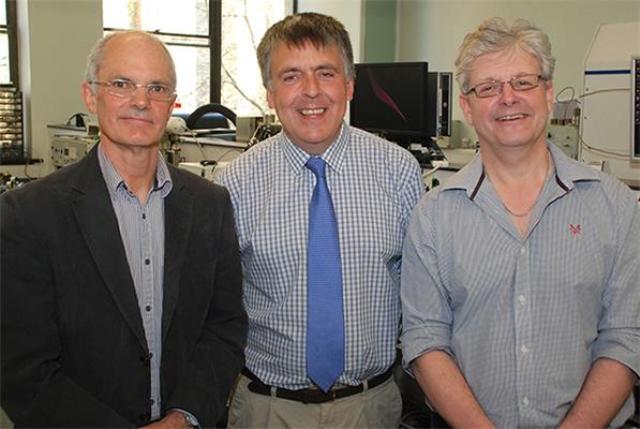May 14 2015
A LEADING innovator in the field of thermal analysis – vital in many fields of advanced manufacturing – has teamed up with the University of Huddersfield for research that will lead to the development of a number of completely new analytical techniques.
 Professor Rob Brown, Dr Gareth Parkes and Professor Mike Reading
Professor Rob Brown, Dr Gareth Parkes and Professor Mike Reading
Professor Mike Reading is founder and research director of the company Cyversa, in this capacity he has invented an algorithm named TASC (Thermal Analysis for Structural Characterisation). The firm Linkam, which manufactures hot stages for optical microscopes, has now incorporated TASC into one of its products. The result is an industry-leading system for the characterisation of materials.
Last year, Professor Reading was awarded a part-time research professorship at the University of Huddersfield, where he is carrying out inter-disciplinary collaboration with scientists based in several department and schools.
University researchers are now working on an extension to the TASC algorithm to create a groundbreaking all-new technique named Chemical Imaging by Dissolution Analysis (CIDA) – a nanoscale method for studying the distribution of components in solid mixtures.
“It will be used, for example, to understand the ways in which the dissolution behaviour of solid pharmaceutical formulations depend on the way these formulations are prepared,” said Professor Rob Brown, who is Director of the Materials and Catalysis Research Centre in the Department of Chemical Sciences. He is one of the University of Huddersfield scientists involved in the collaboration with Professor Reading.
Also involved will be Dr Gareth Parkes of the Department of Chemical Sciences, Professor Barbara Conway in the Department of Pharmacy and Dr Leigh Fleming from the Centre for Precision Technologies.
The development of CIDA
Research Fellow Dr Muhammad Usman Ghori, is working with Professor Reading on the development of CIDA. He is using the Atomic Force Microscope in the School of Computing and Engineering to image composite materials as they are treated with selective dissolution media. Dr Ghori completed his PhD (Drug Delivery) in 2014, under the supervision of Professor Barbara Conway.
“The TASC algorithm, as incorporated into the system marketed by Linkam, will be further enhanced as a result of the University of Huddersfield collaboration, but it already has unique capabilities,” said Professor Reading.
“It enables the measurement of transition temperatures to be carried out on a very small scale in a precisely-defined place,” he said. Crucially, the TASC system enables the user to analyse the effects of heat on different parts of composite materials, which normal thermal analysis techniques do not allow.
Professor Reading is delighted that he and his company Cyversa have forged a partnership with the University of Huddersfield, which, he says, has “a culture that is so supportive of innovation”. He himself has worked in both the industrial and academic sector and has a long track record as an inventor in the field of thermal analysis and imaging techniques.